There Is More War in the Classroom Than You Think
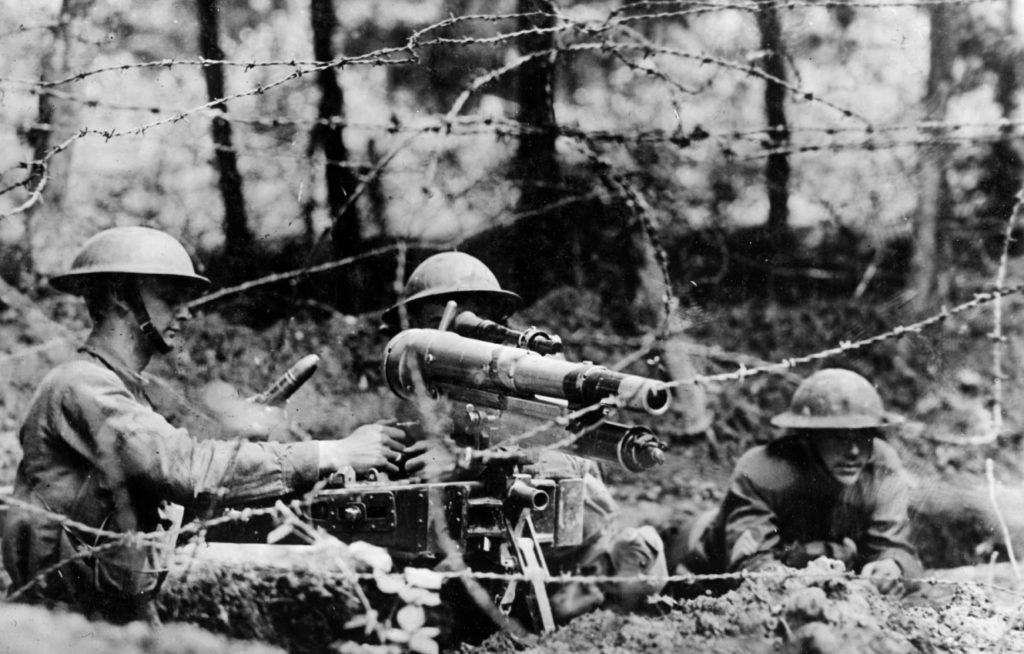
History is dying on college campuses. At least, that’s the assessment of some leading historians. Majors are plummeting and students are leaving college without a firm grasp of the foundations of the modern world. The cause of this decline is hard to pin down. Some scholars believe the fall-off can be ascribed to an aversion toward political history, while in a January 2021 opinion piece, the distinguished author Max Hastings declared that the very study of war has been killed off on college campuses.
In his provocative essay titled “American Universities Declare War on Military History,” Hastings argues that the study of war in U.S. universities is in “spectacular eclipse.” Historians today, averse to military affairs, are concerned principally with, in his words, “culture, race and ethnicity.” So great is this “revulsion from war history,” Hastings believes, that scholars refuse to teach, “or even allow their universities to host,” courses on war. Hastings rues the alleged decline of war studies because he believes in the old adage that the best way to avoid conflict is to study it.
Hastings is a great military historian, but the portrait he paints in his article is inaccurate. Whatever the cause of the decline in history majors, it is not due to a lack of classes on war-related themes. Indeed, the evidence we have collected shows the enduring presence of courses on war in leading American history departments. Based on a detailed examination of course offerings over a six-year period, we conclude that the teaching of war and conflict is doing quite well in history departments across the United States. Furthermore, courses in the field are taught mostly by tenure-track faculty; they are taught at both the survey and advanced level; and even using a fairly narrow definition of what constitutes “war studies,” the subject matter covered is wide-ranging across the modern era. The American Revolutionary War, the U.S. Civil War, the two world wars, regional conflicts like the Vietnam War, and even the “Global War on Terror” all appear consistently in history department offerings across the country, as do courses in the general category of “military history.” Surely, those of us who work in the field would welcome even more course-offerings. But in no way have historians “declared war” on this field.
A Look at the Data
To test the hypothesis about the death of war studies, we started with U.S. News and World Report’s list of the top 75 universities in the United States. Limiting ourselves to these schools unfortunately omitted some excellent institutions known for their strengths in military history such as the University of Kansas (ranked number 124 by U.S. News and World Report), Kansas State University (170), and North Carolina State University (80). We also did not include the service academies in our study. Furthermore, Ohio State University, which has long boasted depth in the field, does not make available its course catalogue by semester, making it hard to know when courses have been taught. So the picture nationally is surely a good bit better than our findings reveal. Of our top 75 schools, 50 publish their course offerings by semester going back to fall 2018, and 39 publish that data going back to fall 2015. Our single most important conclusion, which decisively contradicts the Hastings thesis, is this: Every single one of the 50 schools we were able to examine offers history courses on some aspect of war.
What is more, the average number of war-related courses offered in these 39 history departments each year is 6.4. That may not sound like very many, but it constitutes on average 7 percent of the total annual offerings — surely a higher share than, say, courses on the histories of India, China, Africa, or the Middle East, to say nothing of classics, economic and business history, and the history of science, among other subjects. The most commonly taught courses that deal with war are on general military history and World War II, closely followed by those on the U.S. Civil War and courses on America in the world or U.S. foreign relations. Next in line are those on the Cold War. One might argue that courses on the Cold War should not count as “military history.” But any survey of the Cold War will normally include extensive study of military institutions, intelligence, strategy, and leadership as well as active wars from Korea to Vietnam to the Gulf War. Given this data, it is hard to claim that U.S. universities have declared war on military history. In fact, courses on war are everywhere.
Figure 1: Undergraduate students at select universities have had access to over 200 courses related to the study of war per academic year since fall 2015.
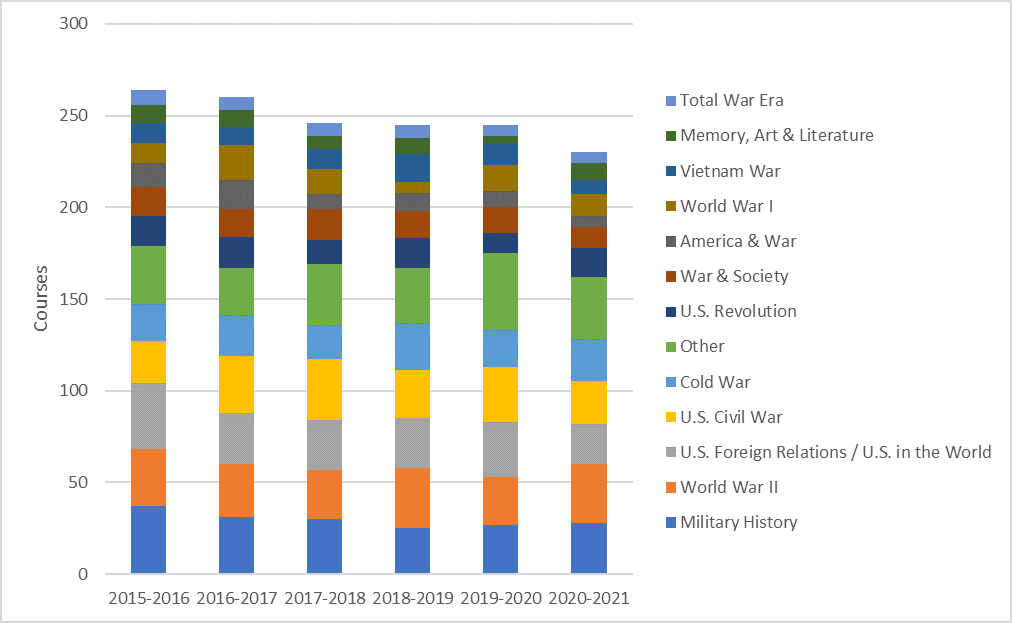
Source: Chart generated by authors using course catalogues from 39 of U.S. News and World Report’s top 75 universities.
Figure 2: Discounting courses on U.S. foreign relations and the Cold War, American universities have offered numerous courses over the last six years on modern wars.
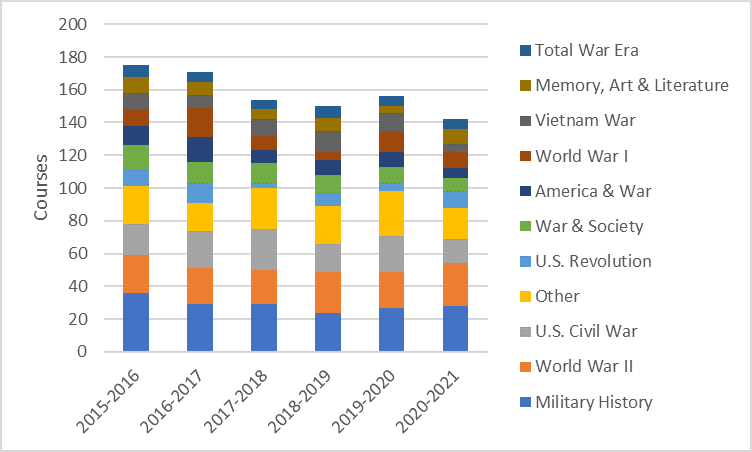
Source: Chart generated by authors using course catalogues from 39 of U.S. News and World Report’s top 75 universities.
In his essay, Hastings relates woeful accounts from faculty at Harvard and Yale to suggest that American higher education has turned its back on military history. But the allegation of decline is not even true in the Ivy League. Over the last three years, among the six Ivy League schools that publish their course offerings, each offered an average of six courses on the study of war each year, in line with the national average.
War studies have not vanished from America’s elite universities. There is, however, significant variation among the Ivies. Yale and the University of Pennsylvania offer an average of nine and 10 courses per year, respectively. Columbia University is not far behind, with an average of eight. Princeton, however, is below average, with only five courses, and Harvard and Brown each offer only an average of four courses related to war each year. (Cornell and Dartmouth do not publish comparable course data.) In Hastings’ essay, Paul Kennedy, a leading historian of military and strategic history, lends his voice to the thesis of decline and fall of military history. Yet the Yale course catalogue tells a less woeful story. Going back to 2015, we found that the Yale history department offered 21 war-themed courses, with some offered more than once, at both the survey level and the research seminar level. These include classes on the Vietnam Wars, the American Revolution, the U.S. Civil War, general military history, religion and war, grand strategy, the Cold War, the Crusades, the Spanish Civil War, World War II, and even one titled “The War at Sea in the Age of Sail.” This array hardly supports the thesis of “spectacular eclipse.”
Figure 3: Ivy League schools have offered a diverse array of courses on some aspect of war over the last three academic years.
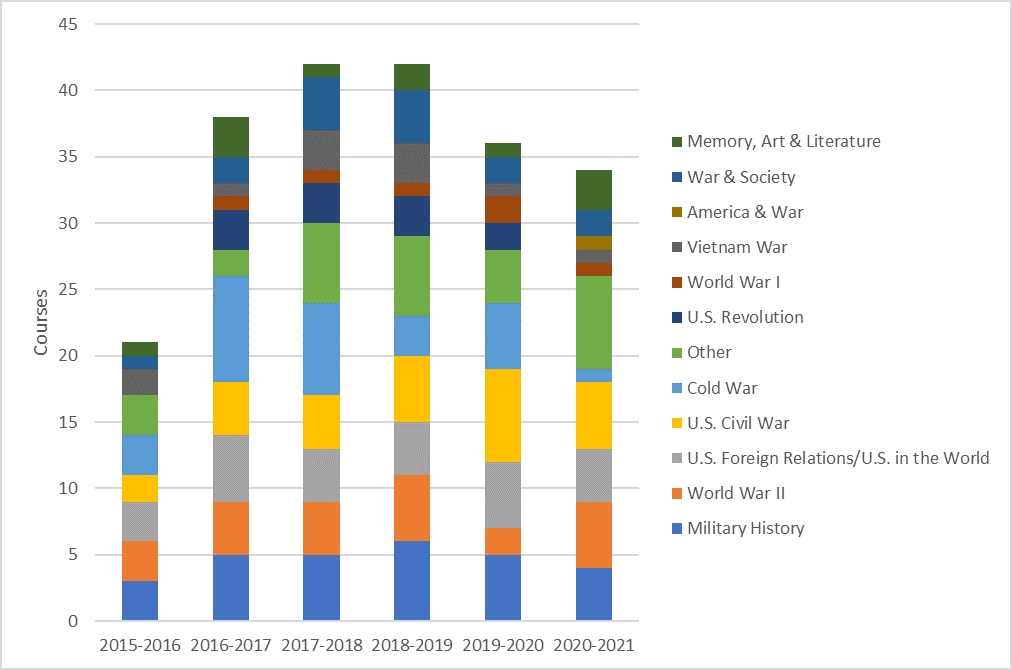
Source: Chart generated by authors using course catalogues of six Ivy League schools.
What about the faculty who teach in this field? One sign that universities do not value a given field might be an increase in courses taught by adjunct faculty or temporary lecturers. Again, the data tells a contrary story. Over the last six years, the percentage of classes in the field of war studies taught by tenure-track faculty has remained consistently high. Full-time tenure-track faculty taught 75 percent of the courses that deal with war. And that proportion has stayed fairly stable. In fact, a slightly higher percentage of these courses were taught by ladder faculty in the 2020–2021 academic year than in the 2015–2016 academic year.
Figure 4: The percentage of classes on some aspect of war taught by tenure-track faculty has remained consistently high.
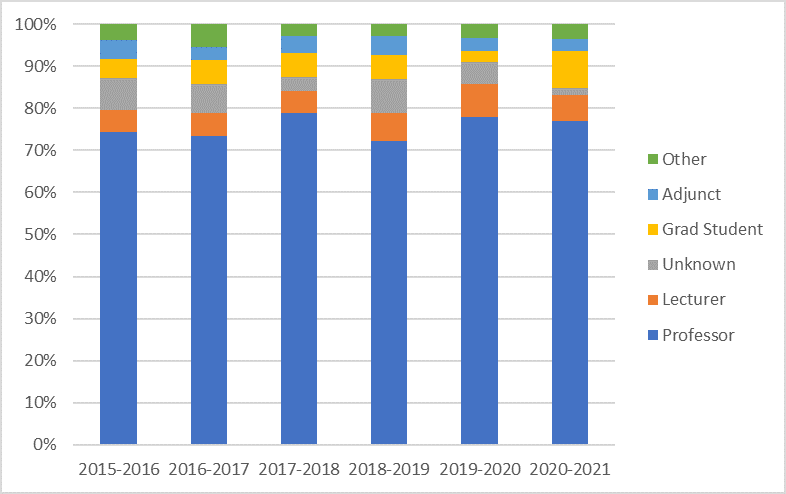
Source: Chart generated by authors using data from course catalogues and department websites.
Figure 5: On average over six years, 75 percent of war-related courses have been taught by tenure-track faculty.
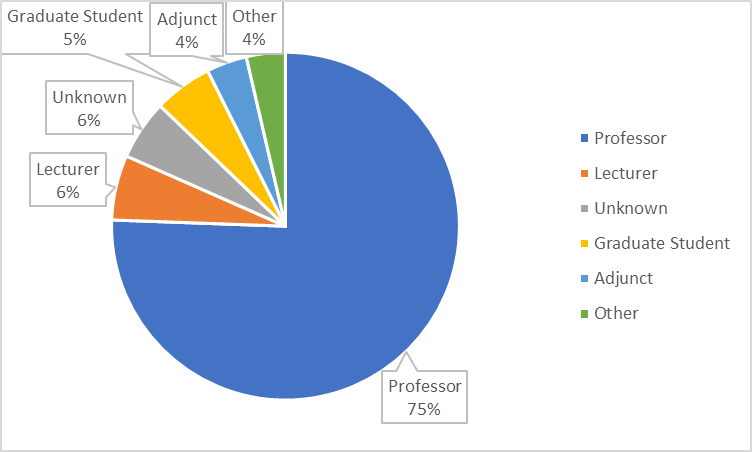
Source: Charted generated by authors using data from course catalogues and department websites.
To be sure, the data reveals a slight falling-off in the overall number of courses on military themes over the last six years. The largest decline (measured by the number of courses taught in the 2015–2016 academic year versus the number taught in the 2020–2021 academic year) is in courses on “America in the world” (or “U.S. foreign relations”). The next largest decline is in courses on general military history, followed by courses on America and war and on war and society. If we focus only on courses that fit our narrowest definition of “war studies” and omit the classes on diplomacy and foreign relations, we find that the largest decline is in courses on general military history followed by courses on war and society, America and war, and the Vietnam War. However, it is worth noting that in the 39 schools we were able to examine going back to fall 2015, more courses were taught on the Vietnam War in academic year 2018–2019 (15) than were taught in either 2015–2016 (11) or 2020–2021 (eight). And the 2020–2021 academic year represents a slight increase in the number of classes on “military history” (28) over the number taught in academic year 2018–2019 (25). So the slight overall decline masks a high degree of variability year by year in particular subjects. The general trajectory is a modest but perhaps insignificant decline.
Some institutions do much better than others at offering a wide array of war-related classes. Among the 39 schools for which the six-year data was available, the University of North Carolina at Chapel Hill and the University of Texas at Austin tie for the highest average number of courses offered per year, at 13. Perhaps unsurprisingly, in our study we found that the tech-focused schools Caltech and Georgia Tech rank among the schools with the lowest annual average of war-themed courses — only two. But also close to the bottom are Harvard, with an average of four, and Johns Hopkins, with an average of three. Stanford is one of the clear leaders in the teaching of war, with an average of 14 courses offered per year over the last three academic years. But of those courses, an average of eight per year are taught by lecturers, versus an average of five taught by tenure-track faculty.
What Is ‘Military History’?
While the evidence decisively shows that courses on military history and war continue to be taught in America’s leading universities, there may be a larger debate worth having about just what kind of military history should be taught, and what value the subject is to undergraduates generally. It is perhaps possible to make an argument that too few university-based historians are actively teaching operational military history — courses limited chiefly to weapons, battlefield tactics, and the evolution of military doctrine within specific national militaries (though our study shows there is still plenty of general military history offered in elite schools). But typically, most college-level courses on war are characterized by a broad analytical framework that includes the social, economic, and ideological dimensions of war. Scholars adopting such an approach grapple with profound questions: What ideas motivate people to begin and to sustain a prolonged conflict? What impact does war have upon social movements, civil liberties, race and gender relations, the environment, and humanitarian attitudes? What ethical questions must the student of war confront? And should not diplomacy, war’s happier sibling, be a central component of any class that treats the origins of war or indeed the aftermath of conflict?
Certainly, such an integrated approach defined the work of Michael Howard, the great military historian and founder of the Department of War Studies at King’s College, London. Hastings rightly invokes Howard as a model for all of us who wish to knit together the study of war with the study of the human societies that fight them. One of us (Hitchcock) served as Howard’s teaching assistant in the late 1980s in his Yale course called “War and Society in Modern Europe” and marveled at the way that Howard, in his lectures, linked national political structures, economies, technology, and ideology with analysis of military performance on the battlefield. He embraced military history as the study of war and society and would have considered it profoundly ahistorical to separate the two. Hastings, in his excellent scholarship, has followed in Howard’s footsteps, linking battlefield developments to broader social, cultural, and ideological forces.
This integration of battlefield events with the social, cultural, ideological, and technological forces that often trigger and perpetuate war is just what the Society for Military History has called for. In November 2014, two of the best scholars in the business, Robert Citino and Tami Davis Biddle, authored a lucid and compelling statement about the importance of teaching the history of war — in all its various dimensions. “Perhaps the best way for military historians to make their case to the broader profession,” they wrote, “is to highlight the range, diversity, and breadth of the recent scholarship in military history, as well as the dramatic evolution of the field in recent decades.” A broadly based and scholarly approach to the teaching of war, they added, “puts big strategic decisions about war and peace into context; it draws linkages and contrasts between a nation’s socio-political culture and its military culture; it helps illuminate ways in which a polity’s public and national narrative is shaped over time. All this gives the field relevance, and, indeed, urgency, inside the classroom.”
The good news is that America’s top history departments are regularly rising to this challenge. Criticism from outside the academy that overlooks these on-going efforts to sustain and deepen our study of war is unfair to the efforts of historians inside college classrooms who are putting in the hard work of linking the history of war to larger social, political, and economic forces. Naturally, scholars will follow varying paths as they grapple with the problem of war in history. There will always be college teachers who emphasize, say, slavery and abolitionism more than battlefield innovations like the hollow-end bullet called the Minié ball in classes on the U.S. Civil War. Likewise, there are going to be teachers of World War II who devote more time to Nazi racial theory than to the Norden bombsight. But the field is large enough for variation in method. The real challenge for those of us who teach courses on war is to find an appropriate balance between war as it is fought and war as it is lived — between war as a practice undertaken by soldiers and war as a ghastly human experience that upends entire societies and takes millions of lives. The evidence suggests that many historians in U.S. universities understand that war is a constant feature of human history and they are working diligently to introduce this phenomenon to their students.
William I. Hitchcock is the William W. Corcoran Professor of History at the University of Virginia and the director of GAGE (Governing America in a Global Era). @GAGE_UVA
Meghan V. Herwig is a Ph.D. student in history and the Brian Layton Blades Jefferson Fellow at the University of Virginia and was the 2020-2021 GAGE Fellow. Her dissertation examines why and how, in the late 1980s and early 1990s, the world’s major economies in North America, Europe, and East Asia overcame protectionist pressures to construct an open global trade system.
Image: U.S. Army

